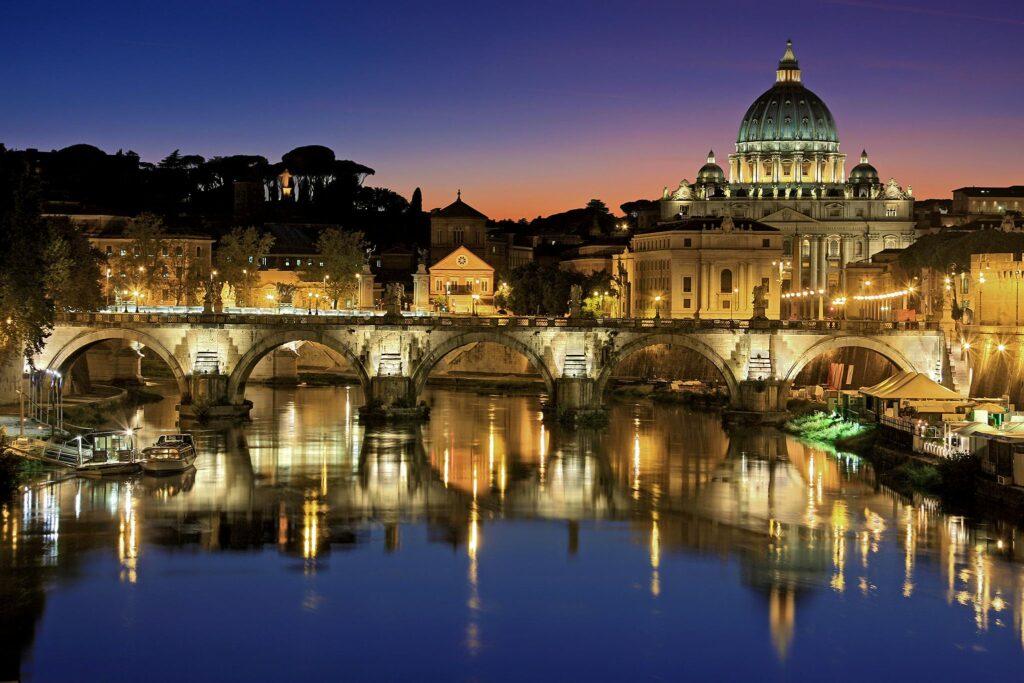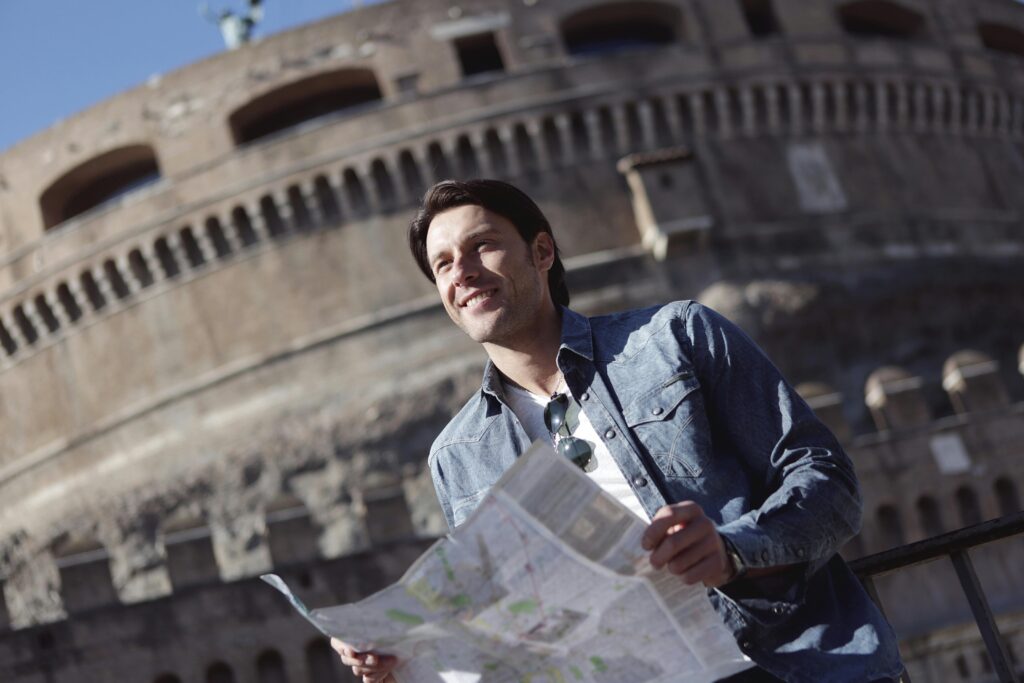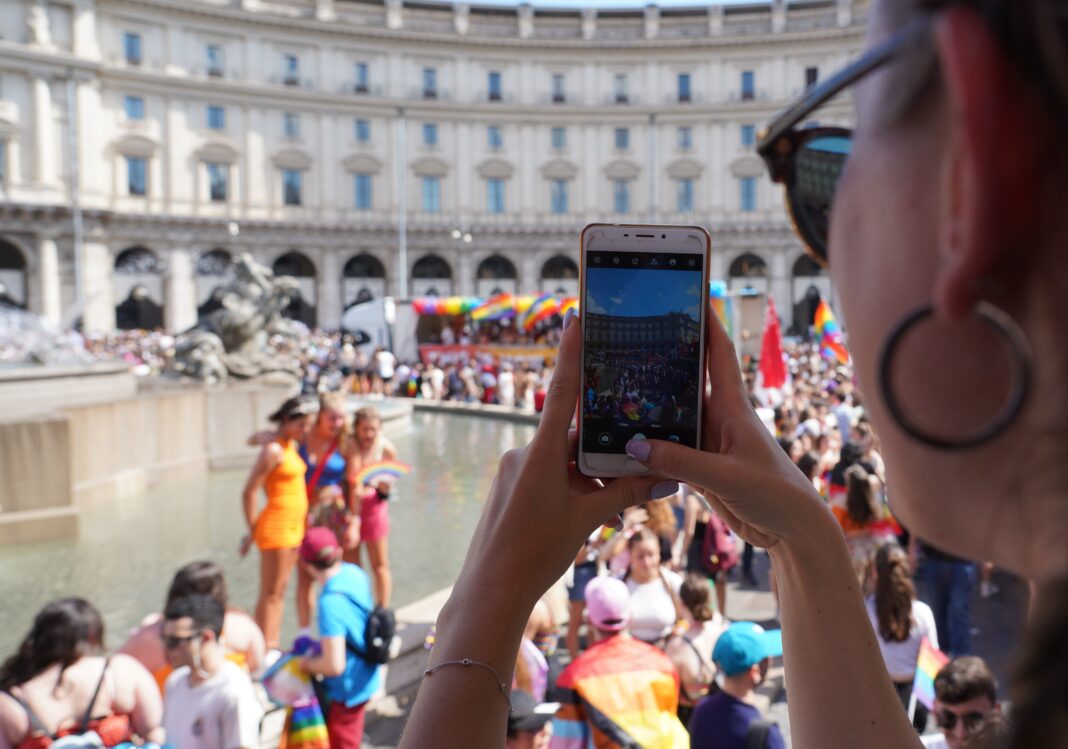Just a mention of Rome conjures sun-bleached ruins, tangles of pasta and nail-biting Vespa rides down cobblestone alleys. Architecture geeks imagine the neoclassical splendor of the Victor Emmanuel II Monument. Classic film lovers imagine Audrey Hepburn languishing on the Spanish Steps. Men into men think of what Russell Crowe would have really done to Joaquin Phoenix in 2000’s Gladiator.
Rome, the Eternal City, has a seductive pull, and the Romans themselves serve as the romantic and dramatic custodians of its riches. Beyond the glossy image sold by Italy’s tourism sector, Rome, which has a population of about 4.3 million, works on multiple levels, and on one such level exists a writhing sensuality that creeps through the city’s Baroque curlicues and cracked stucco façades. Visitors won’t find Pride flags everywhere, but they will encounter a quivering queerness just waiting to be stirred.

Queer life in Rome isn’t as visible as in, say, Barcelona or Paris. Rather, Rome’s queers revel in the mere unlikeliness of their existence. With the city-state Vatican right in their backyard (population: 882), they have carved out space for drag shows, queer poetry nights, queer art collectives—anything naughty, anything campy and anything that involves dressing up. LGBTQ+ couples lean into each other as they walk and linger along the Tiber, not challenging people with their love but celebrating it stylishly nonetheless.
Queerness is nothing new for Italy’s capital. In the time of the Roman Empire, same-sex love was not just embraced but carved into marble. Emperor Hadrian, who ruled from 117 to 138, had an affection for his young lover Antinous that inspired statues, temples and a now-obsolete astronomical constellation. (In 132 CE, Hadrian defined the Antinous constellation, but it was later assimilated into the heternormative “Aquila” constellation, representing the bird that carried Zeus’/Jupiter’s thunderbolts.)
The rise of Christianity and centuries of Roman Catholic dominance summoned a tide of suppression that consigned queers to the shadows. Modern Italy has recognized same-gender civil unions since 2016, but is yet to legalize marriage equality. Compared to its neighbours in Western Europe (and even some in Central and Eastern Europe), Italy has significant work to do on behalf of its queer citizens. Adoption, for example, is only available to second parents. That reality has become a source of embarrassment for liberal Italians, who are a majority. (A 2023 survey reported that 64 percent of Italians support same-sex adoption. Eighty percent support protections against transgender discrimination, though such laws are inconsistent across the country.)
Yet Rome’s queer population endures—they live in the Eternal City, after all—and they throw a great party every summer. The city’s annual Pride parade weaves past both classic monuments and Catholic shrines with unapologetic glee. For better or worse, even outside of Pride season, Rome’s queers will cheer on anyone they find especially attractive.
Though there are bars, it’s the queer parties where a visitor will find the most fun. Attend the megarave Muccassassina in the famed Baths of Caracalla or a queer film screening in a San Lorenzo courtyard. There’s much to explore beyond Rome’s unofficial “Gay Street,” Via di San Giovanni in Laterano, which is nestled next to the Colosseum. The Trastevere neighbourhood whips up spicy Italian drama with its candlelit restaurants, perfect for both soft-focus romantic dinner selfies and midnight gelato. The neighbourhood of Pigneto, on the other hand, is a tattooed rebellious artist, emotionally distant and impossibly cool. San Lorenzo is punkishly political, while the warm and residential Testaccio summons locals to its authentic trattorias.
Speaking of food, visitors can rarely do wrong in Rome (unless they wander, perhaps on the verge of heat stroke, into one of the overpriced tourist traps near the Vatican that reheats microwavable pizza and then charges you CA$27 for it). Food in Rome is meant to be savoured. Roman trattorias now enjoy the same status as the Temple of Jupiter did 2,000 years ago. Marvel at the deep-fried artichokes, golden carbonara, and cacio e pepe (cheese and pepper) pizzas. Take your time. Woo your waiter. Learn Italian. Even having five words in one’s repertoire will earn regal status. For Italians, speaking their language in a foreign accent will be viewed as foreplay.
Try to visit in the spring. Pride is great and all, but queer events happen throughout the year, rendering a visit unnecessary when it’s 40°C. An ideal Italian lover, coiffed hair, tailored shirt et al., can still be found, perhaps offering a passionate kiss in an alleyway.
Will they ghost you? Probably. But you’ll forgive them and find another. After all: When in Rome, do the Romans. Here is the best of LGBTQ+ Rome.
Pride
Roma Pride (usually mid-June; 2026 TBA). In 2023, the Lazio region, which includes Rome, revoked its support for the parade, which, while not illegal, is political and defiant. The 2025 parade was built around 12 demands, ranging from trans and nonbinary rights to judicial resistance. The official party side of Pride is usually hosted by a local promoter like Muccassassina.
What to see and do

Colosseum, Roman Forum and Palatine Hill (Piazza del Colosseo 1, Rome). These monuments of Ancient Roman culture lie within feet of each other, forming a triumvirate of classic tourist destinations. If you go on a queer tour, you’ll hear about the many gladiators with gay lovers, or how Julius Caesar, whose remains lie in the Forum, bottomed for the King of Bithynia.
The Sistine Chapel (The Vatican Museums, Vatican City). After an awe-inducing stroll through the many halls and collections of the Vatican Museums, visitors will come upon this cavernous, fresco-covered chapel featuring Renaissance-era masterpieces by Perugino, Botticelli and of course, the famously queer Michelangelo. Those who look closely at Michelangelo’s storied ceiling will find several depictions of men kissing.
Saint Peter’s Basilica (Piazza San Pietro, Vatican City). Even those without a religious bone in their body will appreciate the sheer drama and scale of this Late Renaissance ode to Catholicism. The Michelangelo-designed dome leaves many speechless.
Borghese Gallery (Piazzale Scipione Borghese 5, Rome). This gallery’s sculptural masterpieces, like Bernini’s The Abduction of Proserpina, ensnare visitors with their Baroque high drama. Meanwhile, the walls boast several recognizable masterpieces from the supposedly bisexual Italian Renaissance painter Caravaggio.
Pantheon (Piazza della Rotonda, Rome). Emperor Hadrian, who was openly into guys, helped restore this impressive ancient structure, which was once a shrine to Roman gods and is still intact thanks to some brilliant Roman engineering. Of course, any shrine to Roman gods is inherently queer; Jupiter himself was known to visit a young man named Ganymedes from time to time.
Trevi Fountain (Piazza di Trevi, Rome). This rococo tour de force marks the terminal point of a prominent ancient aqueduct. It’s also undeniably romantic, especially at dawn or at midnight, when the snaking lines have disappeared.
The Spanish Steps (Piazza di Spagna, Rome). Those who have seen the film Roman Holiday might associate these steps with Audrey Hepburn living her full princess fantasy. It’s where Joe Bradley (Gregory Peck) tells Princess Anne, “Live dangerously, take the whole day.” Meanwhile, those who have seen The Lizzie McGuire Movie might associate them with the line, “Goodbye Lizzie McGuire, hello fabulous!” Anyway, the Spanish Steps are iconic.
The Capitoline Museums (Piazza del Campidoglio 1, Rome). Here, visitors can find a famous statue of Romulus and Remus and their she-wolf adoptive mother, as well as a marble statue of Antinous, Hadrian’s gay lover.
MAXXI—National Museum of 21st Century Art (Via Guido Reni 4a, Quartiere I Flaminio, Rome). Designed by Zaha Hadid and opened in 2010, the museum is as well known for its architecture as for what’s inside. Indeed, it’s a twofer: a museum of architecture, and a museum of contemporary art, mostly expressed in special exhibits and its 400-work collection. In a country full of the ancient, it’s one of the few major institutions dedicated to “contemporary creativity.”
MACRO—Museo d’Arte Contemporanea di Roma (V. Nizza 138, Roma). Located in a former brewery and inaugurated as an art gallery in 1999, this museum often exhibits works about gender, sexuality and body politics through feminist, queer and alternative perspectives.
Baths of Caracalla (Viale delle Terme di Caracalla, Roma). The city’s second largest Roman public baths were known as a place for same-sex canoodling. They can be visited during the day for a fee, but they might be more interesting to see when gay promoter Muccassassina hosts one of its summer “Arena Rome” parties here.
Circolo di Cultura Omosessuale Mario Mieli (Via Efeso 2A, Roma). Named after Italy’s most famous gay rights activist, this community centre may not be a major sight, but it’s smart to keep an eye out for what cultural offerings and events they might be presenting during a visit.
Angelo Mai—Circolo Arci (Viale delle Terme di Caracalla 55, Rome). A collective of theatre artists, musicians, and cultural and entertainment workers founded this laboratory for artistic experimentation and political activism in 2004. Though not exclusively LGBTQ+-focused, many of their projects have a queer flavour. Though music, dance and dancing are on offer, the theatrical productions might require an understanding of Italian.
Where to stay
Hotel Pantheon (Via dei Pastini 131, Rome). Between its 18th century exterior and neo-baroque wooden panelling, Hotel Pantheon serves as a nice foil to its nearby Roman namesake. The cozy bar is a good place to make friends.
Hotel Hassler Roma (Piazza della Trinità dei Monti 6, Rome). Perhaps the most refined queer-friendly hotel in Rome, the five-star Hassler is worth the price if you can afford it. It’s one of Luke Evans’ preferred places to stay in the city. That’s no surprise, considering its superb spa and prime location overlooking the Spanish Steps.
Hotel Artemide (Via Nazionale 22, Rome). Perfect for mid-budget travellers, Artemide welcomes many same-gender couples into its 19th-century walls, providing a great homebase near the Trevi Fountain. The marble lobby and tasteful art transport guests to times long past.
YellowSquare Rome (Via Palestro 51, Rome). Home to one of Rome’s most popular gay bars, YellowSquare packs all the fun of a queer hostel into the frame of a mid-budget comfort stay. Take advantage of the rooftop yoga after a flirty night at Yellow Bar downstairs (see listing below).
Sofitel Roma Villa Borghese (Via Lombardia 47, Rome). Art lovers will rejoice at this five-star stay within walking distance of the Borghese Gallery. The high-end on-site Mediterranean restaurant doesn’t hurt, either. From the LGBTQ+-friendly Accor hotel brand.
B&B First Floor/Second Floor (Via di S. Giovanni in Laterano 10, Rome). Though it was previously called B&B Second Floor, now there are two floors, located right on Rome’s “Gay Street.” Of the rooms named after famous queers like Freddie Mercury and Sappho, Michelangelo and Rimbaud are the ones with views of the Colosseum. Their LGBTQ+-focused restaurant, Coming Out, run by a lesbian couple, is listed below in our Where to party section.
Where to eat
Risotteria Melotti (V. della Vetrina 12a/b, Rome). This centrally located spot is a great place to try risotto or supplì (Rome’s answers to arancini, or rice balls).
Da Tonino—Trattoria Bassetti (V. del Governo Vecchio 18-19, Rome). Da Tonino earns rave reviews from locals and tourists alike for everything from its tagliatelle to its tiramisu.
Dar Filettaro a Santa Barbara (Largo dei Librari, 88, Rome). Seafood lovers flock to this no-frills, homey diner for its fried cod, which is perhaps the best in town.
Piccolo Arancio (Vicolo Scanderbeg 112, Rome). Waiting in line at Trevi Fountain can make people grumpy—and hungry. Thankfully, this nearby diner with country flair whips up some delicious traditional dishes.
Corner Pizza e Tiramisù (Piazza del Teatro di Pompeo 20, Rome). This snug, standing room–only joint is an excellent place to grab a perfectly crunchy cacio e pepe pizza while on the go.
La Taverna del Ghetto (Via del Portico d’Ottavia 8, Rome). The Jewish Quarter is an essential place to visit if you’re interested in Rome’s famous fried artichokes. La Taverna is the place to get them.
Gelateria Artigianale Corona Roma (Largo Arenula 27, Rome). It’s hard to go wrong with gelato in Rome, but this blink-and-you’ll-miss-it gelateria near Julius Caesar’s assassination site is a hit among locals.
Limon’è (Via di Tor Millina 10/11 and other locations, Rome). You may as well engage in Italy’s national pastime of drinking limoncello while you’re in Rome. At Limon’è, you can also try lemon desserts.
Where to party
Coming Out (Via di S. Giovanni in Laterano 8, Rome). No iconic queer Rome experience can bypass Coming Out, which, along with My Bar next door (listed below), forms the nucleus of queer life in Rome. Though the lesbian-run venue serves breakfast, lunch and dinner, and so could be listed under Where to eat, it’s better known for its nighttime antics, including live music, karaoke and shows. Drag on Mondays, Wednesdays and Saturdays. Every other bar in the city is just an electron doomed to circle it.
My Bar (Via di S. Giovanni in Laterano 12, Rome). Located next door to Coming Out on “Gay Street,” My Bar encourages partiers to merge with Coming Out’s crowd, creating a lively street party. Karaoke nights and exotic dancers kick things up a notch.
Company ROMA (Piazza Manfredo Fanti 40, Rome). Bears are in good company here; it’s their main drinking den in Rome. Company becomes quite cruisy later in the evening, when it morphs into a dance venue.
Bear Markett (usually but not always at Alibi Club, Via di Monte Testaccio 44/40, Rome). The Alibi Club also hosts other queer parties and cultural events. For the bears, it’s hot, sweaty dancing.
Yellow Bar (Via Palestro, 40, Rome). Helpfully located in a hostel for quick access to a bed, the straight-friendly Yellow Bar combines a cute, young crowd with live music and well-priced cocktails.
Lanificio (Via di Pietralata 159A, Rome). The gay-friendly Lanificio crowd runs younger, artsier, punkier and more fashionable. Get lost in the electronic soundscape at this woolen mill-turned-nightclub and watch your problems melt away.
Gender Klub Roma (Via Faleria, 9/11, Rome). Gender Klub is committed to providing a safe space for nonbinary and trans guests. Its seedy-chic underground style makes for a good alternative night out.
101 Club (Via Panisperna 101, Rome). 101’s cadre of international pop music has made it a hit among tourists and locals alike. On top of that, it’s one of the more inclusive spaces in the city, welcoming the full spectrum of queerness into its pansexual walls.
Freni e Frizioni (Via del Politeama 4, Rome). Imported beers and refined martinis react with the hipster crowd in a perfect chemical reaction, creating a congenial atmosphere in this converted mechanic’s shop. Mainstream but LGBTQ+-friendly.
Frutta e Verdura (Via di Santa Passera, 27, Rome). Just as its name, “fruits and vegetables,” implies, this straight-friendly gay club invites all kinds of revellers to vibe with its house and techno beats. Plus, it provides all the nutrition you need: Vitamins T&A, and the all important D.
Malo Glitter Bar (Via Fanfulla da Lodi 3, Rome). An inclusive queer cocktail bar where there’s always something going on, whether it’s karaoke, a show, an art exhibit or even some knitting.
Largo Venue (Via Biordo Michelotti, 2, Rome). This music and performance space, owned by the same folks behind Malo Gitter Bar, attracts a younger crowd. The patio is the place to be in the summertime.
Muccassassina (Viale delle Terme di Caracalla, Rome). This queer party regularly fills the ancient and spectacular Baths of Caracalla, seen previously in John Wick: Chapter 2. It’s trendy, it’s decadent and you might need a real bath afterwards.
Where gay and bi guys can find fun
K Cruising Club (Via Amato Amati 6/8, Rome). K is Rome’s premier leather cruising bar. It’s been luring men into its shadowy crevices since the 1990s. Service-minded, the venue’s got plenty of places to hole away. Not for the faint of heart. Like at many gay sex clubs and saunas in Italy, patrons must buy a membership to Arco, a national “club” that grants entry to many gay members-only spaces.
Skyline Club (Black Hole Club) (Via Pontremoli 36, Rome). Skyline/Black Hole attracts men of all body types, from great to small, studded to naked. The vibes in this cruising bar are chill, but the premises are big. Some of their theme nights, which include nudity and fetish, are open to various members of the LGBTQ+ community, including women-only nights. Check the schedule before dropping by.
Adam Sauna (Via Pontremoli 28, Rome). Adam is within walking distance of Gay Street. So unsurprisingly, it’s the largest and most popular gay sauna in Rome. Its pool, dark room, cabins, steam room, and sauna are perfect places to commit Original Sin.
Apollion Sauna (Via Mecenate 59A, Rome). Just as the handsome, ripped, and bisexual Apollo would have wanted, Apollion packs plenty of naked Adonises into its classy and cozy video, dark room, steam bath and sauna every week.
Il Buco Beach (30 km southwest of Rome). Its name means “the hole,” and once you see what’s on tap, you’ll understand why. This secluded nudie beach is awash with queer Romans celebrating everything the gods gave them.
Where to shop
Libreria Antigone (Via degli Ausoni, 45, Rome). This woman-owned queer and feminist bookstore has branches in both Milan and Rome, as well as rebellious events that keep local queer art alive.
Otherwise Bookshop (V. del Governo Vecchio 80, Rome). This friendly LGBTQ+-owned English-language bookshop is a nice place to run into fellow English speakers, or perhaps stumble into the meeting of a feminist book club or other events.
Tuba (Via del Pigneto 39A, Rome). This women’s bookshop, bar and event space, created by a group of feminists and lesbians, is dedicated to fighting against discrimination based on gender, sexual orientation, class, skin colour and geographical origin. With vegan options among their many menu options, and an extensive drink menu, we could easily have listed them under Where to eat or Where to party.
Versace (Piazza Di Spagna, Via di S. Sebastianello 12, Rome). Shop local? Just a few Spanish Steps away from Rome’s iconic luxury shopping street Via dei Condotti, Versace continues to celebrate flamboyance in both fashion and human form.
Fendi (Largo Carlo Goldoni 420, Rome). As one of Italy’s most iconic fashion brands, Fendi deserves at least an appreciative look during any self-respecting Roman holiday.
Zegna Boutique (Via Borgognona 7E, Rome). This high-end men’s apparel shop sells clothes both relaxed and refined. Visitors appreciate the complex and loving tailoring process that they undergo when buying suits here.
Zou Zou (Via della Cancelleria 9A, Rome). This classy LGBTQ+-friendly store is dedicated to sex toys and sensual and sometimes kinky undergarments.


